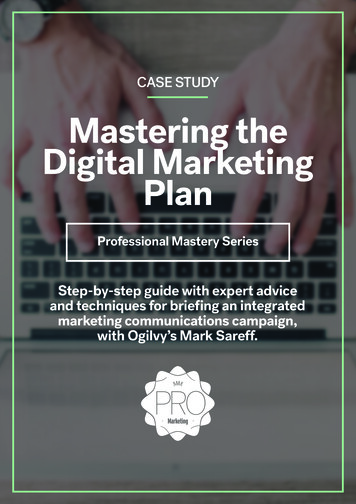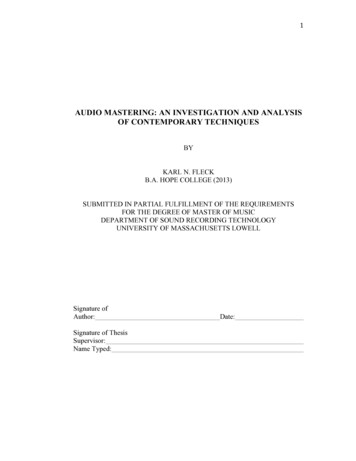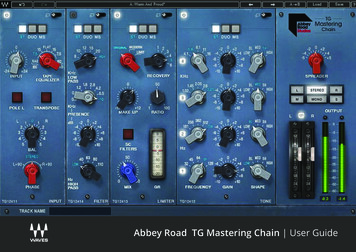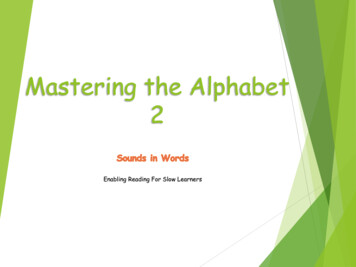
Transcription
CASE STUDYMastering theDigital MarketingPlanProfessional Mastery SeriesStep-by-step guide with expert adviceand techniques for briefing an integratedmarketing communications campaign,with Ogilvy’s Mark Sareff.
PublisherPAUL LIDGERWOODEditorPETER ROPERpeter.roper@niche.com.auThis premium content is producedand published by Marketing,Australia’s only dedicated resourcefor professional marketers.Marketing Pro members have accessto a comprehensive toolbox ofpremium content.marketingmag.com.au/proCompiled and editedby Belle KwanMany thanks toSteve Hallam atDeloitte Digital for hisexpert guidanceand advice.Sub editorMADELEINE SWAINArt directorKEELY ATKINSDesign & digital pre-pressMONIQUE BLAIRAdvertising enquiriesLUKE HATTYTel: 613 9948 4978luke.hatty@niche.com.auSubscription enquiriesTel: 1800 804 auMarketing is a publication ofNiche Media Pty LtdABN 13 064 613 529.1 Queens Road,Melbourne, VIC 3004Tel 613 9948 4900Fax 613 9948 4999ChairmanNICHOLAS DOWERManaging directorPAUL LIDGERWOODCommercial directorJOANNE DAVIESContent directorCHRIS RENNIEFinancial controllerSONIA JURISTAPrintingGRAPHIC IMPRESSIONSAccounting softwareSAPPHIREONEwww.sapphireone.comMarketing ISSN 1441–7863 2015 Niche Media Pty Ltd. All rights reserved. No part of this publication may be reproduced, stored in a retrievalsystem or transmitted in any form or by any means, electronic, mechanical, photocopying, recording, internet, or otherwise, without the prior writtenpermission of the publishers. While every effort has been made to ensure the accuracy of the information in this publication, the publishers accept noresponsibility or liability for any errors, omissions or resultant consequences including any loss or damage arising from reliance on information in thispublication. The views expressed in this publication are not necessarily endorsed by the editor, publisher or Niche Media Pty Ltd.Niche Media Privacy Policy This issue of Marketing may contain offers, competitions, surveys, subscription offers and premiums that, if you chooseto participate, require you to provide information about yourself. If you provide information about yourself to NICHE MEDIA, NICHE MEDIA will usethe information to provide you with the products or services you have requested (such as subscriptions). We may also provide this information tocontractors who provide the products and services on our behalf (such as mail houses and suppliers of subscriber premiums and promotional prizes).We do not sell your information to third parties under any circumstances, however the suppliers of some of these products and services may retain theinformation we provide for future activities of their own, including direct marketing. NICHE MEDIA will also retain your information and use it to informyou of other NICHE MEDIA promotions and publications from time to time. If you would like to know what information NICHE MEDIA holds about youplease contact The Privacy Officer, NICHE MEDIA PTY LTD, 142 Dorcas Street SOUTH MELBOURNE VIC 3205.Product code: MKATT003marketingmag.com.au/pro
3 GUIDE TOOL: DIGITAL MARKETING STRATEGYRead this firstThis template is for a digital marketing strategy – an ongoingbusiness activity rather than a one-off campaign. It’s useful forbriefing a digital agency as well as a tool for articulating a digitalstrategy for internal use.Q: When it comes to filling in a digitalcampaign brief/template, what are theimportant sections that you would placespecial emphasis on?Steve Hallam: If you are providing a digital agency witha brief, then I think it’s important to focus on the first fewsections of this template, in particular, the sections aboutyour objectives, the marketing environment, and yourstrategies. You should also be upfront about your budget.It is perfectly fine to leave the tactics part for theagency to fill out in their response, or, if you wish, toprovide some suggestions.This is definitely a case of the more information thebetter – if you can give your agency detailed informationabout what you’re trying to achieve and what you thinkmight be a good idea, then that is great – but you alsowant to provide freedom for your agency to innovate too.Your agency will probably think of strategies and tacticsthat you as the procurer might not.Be fluid in your thinking. Be open to accepting new ideasand new direction that you may not even have considered.That’s what you hire an agency for in the first place!Q: Everything is measurable in the digitallandscape; so, how important are specifics interms of objectives, or desired results?SH: This template below is good in that it asks for a lotof objectives-based information. It is always terrific if aclient is able to provide specific outputs that are desired,for example, the number of likes, shares, or page-views,ecommerce leads, or so on.At the same time, we also want to know what yourdesired outcomes are. For example, a desired outcomecould be ‘wanting to be well known in your marketsegment’, and have ‘first of mind recall for a particulartype of product’.Go through the S.M.A.R.T. (Specific, Measurable,Assignable, Realistic, Time-related) framework. That’s apretty good guideline for creating objectives.Additionally, you should ensure that your campaignanalytics, such as tagging and tracking, is robustlydesigned so everything can be measured and attributedaccurately. Ideally this would include an overlay of omnichannel tracking and attribution so you can see the impactacross all of your channels.marketingmag.com.au/pro
4 GUIDE TOOL: DIGITAL MARKETING STRATEGYQ: How does a marketer ensure that a digitalstrategy remains in line with the widerumbrella of marketing objectives in thecompany?SH: When completing this template, you may notice thatinformation is asked for in a logical order, where eachsection provides information that links to the next section.For example, if we’ve set up strategies that will allowus to hit our objectives, and we’ve set up tactics to allowus to hit our strategies, then all we really need to focus onis doing all the tactics and putting together a plan, and bydefault we should hit our objectives.The heart of any good strategy is the linkage betweenobjectives, strategies and tactics.Bear in mind that there has to be consistency acrossyour various digital channels, and that your objectives andstrategies should align with your overall marketing plan.Q: Who should be involved in the completingof this template?SH: Depending on the size of your organisation, in theideal situation, a digital campaign manager should be incharge of this, with input and/or review from the overallmarketing team. There could also be involvement fromthe content and engagement team/s, if they exist in yourorganisation. Otherwise, this is where your agency willcome in.You may also want to involve your CMO and/or theC-suite as well. I would sit down with them to set and/orreview the objectives, and have them help you align yourdigital marketing objectives with the overall business &marketing objectives.Q: What are some of the most commonmistakes you see in digital briefing fromclients?SH: First, you should give consideration to the differenttypes of media as part of your campaign – bought, ownedand earned. If you focus exclusively on bought media, thenyou’re likely missing the impact that your own site/s canhave and how you might earn media mentions from others.Earned media is quite often the most difficult to achievebut often resonates the most with customersSecond, you should baseline your current positionso you have an understanding and measurement of yourcurrent marketing performance prior to commencing acampaign. This will also mean that any uplift that can’t bedirectly attributed to the campaign can also be recognized.Third, the Campaign Measurement (Test and Learn)section is really important. A lot of people tend to set andthen forget. Markets crash and unexpected things happen.Strict campaign monitoring means you remain agile andcan redirect investments if performance isn’t measuringup. It’s also incredibly important to build up a databaseof previous campaigns, with analysis on what has workedand what hasn’t. This way, not only do you prevent pastmistakes from happening, you can also incrementallyimprove on your previous learnings. It will also assist youwith insights on customer journeys and this will in turnhelp you and your agency plan out what an ‘ideal’ customerjourney might look like, and where & how to engage withthe customer.Finally, another major mistake I think someorganisations make is that they think of marketingcampaigns as a project rather than an ongoing businessactivity. Of course, certain times of the year, say Christmas,you do specific campaigns, but even then, it needs to becontinual and speak back to your overall marketing plan.A digital campaign should not be just once-off project – ithas to talk to the past and the future.marketingmag.com.au/pro
5 GUIDE TOOL: DIGITAL MARKETING STRATEGYPart 1: Campaign Objectives1.1 General aims for campaign General marketing aim of campaign and contextProduct categories or services targeted.Sales and lead generation goals.Positioning and brand communication goals.marketingmag.com.au/pro
6 GUIDE TOOL: DIGITAL MARKETING STRATEGY1.2 GoalsWhat do you hope to achieve from this campaign? Provide detailed goals if possible, for instance: Reach (number of prospects reached on third party sites). Incremental unique visitors or visits to site. Incremental social engagement (target number of ‘Likes’ on Facebook, Twitter followers or email signups). Marketing outcomes and conversion rates. Campaign response – leads or sales percentage. Email sign-up percentage. Where to buy and where to be seen.marketingmag.com.au/pro
7 GUIDE TOOL: DIGITAL MARKETING STRATEGY1.3 Branding objectives Brand awareness – how will the campaign increase brand awareness? Brand familiarity – which products are featured in campaign, what is the emphasis? Brand purchase intent goals – how is the campaign intended to directly and indirectly influence sales?1.4 MeasurementWhat will be implemented to measure success?1.5 BudgetBe upfront about how much money has been budgeted for this campaign.marketingmag.com.au/pro
8 GUIDE TOOL: DIGITAL MARKETING STRATEGYPart 2: Market & Environment Analysis2.1 Target audienceTarget audience segmentation and personas: Demographics (Age, gender, social groups, or B2B demographics – members of buying unit, companysize and sector, etcera). Psychographics (interests, attitudes, opinions).marketingmag.com.au/pro
9 GUIDE TOOL: DIGITAL MARKETING STRATEGY2.2 Audience motivations (scenarios) Typical customer motivation and/or scenarios for responding. Customer journeys. Who are the key influencers?2.3 Competitors List direct competitors and their core value propositions. Indirect competitors. Any possible category imitations.marketingmag.com.au/pro
10 GUIDE TOOL: DIGITAL MARKETING STRATEGY2.4 IntermediariesDifferent types of digital channels that you could use to increase audience reach: Horizontal portals and mainstream media. Niche or vertical industry sector media sites. Niche social networks. Aggregators and super affiliates. Small affiliates and blogs.2.5 Media consumptions and buying process Which media sites or portals do your customers typically use, how web savvy are they?What is the process by which they select products (search key phrase sequence)?Who do they trust? Why?How does a brand gain their respect and attention?marketingmag.com.au/pro
11 GUIDE TOOL: DIGITAL MARKETING STRATEGYPart 3: Campaign Strategy3.1 Strategies for each objectiveHow will you address the audience with the offer, message and positioning that you have created? Use any research/insight from section two. Think about: Is your audience online? Is digital the lead or support to traditional offline broadcast media? Are there times of the day when your audience is most likely to be receptive? Timing is everything. Are you looking to interrupt with advertising or build relationships? How can you add value so that the audience is motivated (directly or indirectly) to spread your message for you? Do you want to create excitement with prizes and give-aways or maybe you need to incentivise transactions?marketingmag.com.au/pro
12 GUIDE TOOL: DIGITAL MARKETING STRATEGY3.2 Strategies for each form of media How will you use each of the three types of digital media?Owned: what do you already own and how can you use that to your full advantage?Earned: blogs, social media, partner sites – how to engage and generate interest?Bought: where will you advertise for best impact?3.3 Ideal customer journey pathAppend a customer journey map.marketingmag.com.au/pro
13 GUIDE TOOL: DIGITAL MARKETING STRATEGYPart 4: Tactics4.1 Campaign conceptThe hook, theme or main message you want the audience to recall and act upon.4.2 Value proposition Outline the benefits to the customer and the corresponding features that deliver these benefits.How does the value proposition differ per channel and which channel is preferable and why?Why would someone take up an offer and what would make them not?marketingmag.com.au/pro
14 GUIDE TOOL: DIGITAL MARKETING STRATEGY4.3 Ideas for main creative conceptWhat attracts attention and proves relevance to potential customer?4.4 Owned media How will you produce content that is suitable and attractive?Optional: insert or append a content strategy document – can any existing content be used?marketingmag.com.au/pro
15 GUIDE TOOL: DIGITAL MARKETING STRATEGY4.5 Earned media Part of your campaign might be reaching advocates:How do you attract key influencers?What will they like?How do you reward them?4.6 CredibilityHow do you prove what you say is valid?marketingmag.com.au/pro
16 GUIDE TOOL: DIGITAL MARKETING STRATEGY4.7 Key brand messagesNot all prospects will be familiar with your brand. What are the brand values or the brand essence that you want tocommunicate? For example: price, convenience or quality based.4.8 Tone of voiceHow do you want to sound? For example: straightforward, friend or adviser. Serious. Energetic. Dynamic.marketingmag.com.au/pro
17 GUIDE TOOL: DIGITAL MARKETING STRATEGY4.9 CreativeOpportunities and collateral available for: Rich media and video. Content and guides. Viral effect – what will be the viral agent?marketingmag.com.au/pro
18 GUIDE TOOL: DIGITAL MARKETING STRATEGYPart 5: Campaign Plan and Budget5.1 Bought mediaOnline potential media sources. Specify sequence and their approximate budget split: Paid search ads. Display ads. Search engine optimisation. Third-party enewsletter ads. Website downloads.marketingmag.com.au/pro
19 GUIDE TOOL: DIGITAL MARKETING STRATEGY5.2 Owned media Co-branded campaigns.House lists.Communications on website.Additional content.5.3 Earned media Blogs and RSS.Social media marketing.Viral marketing.marketingmag.com.au/pro
20 GUIDE TOOL: DIGITAL MARKETING STRATEGY5.4 Available budgetTotal budget available for: Strategy, planning and research. Creative and content assets (eg. videos). Bought media. Earned media. Testing and in-campaign optimisation.5.5 Cross-channel integrationHow should this activity integrate with other marketing activity?marketingmag.com.au/pro
21 GUIDE TOOL: DIGITAL MARKETING STRATEGYPart 6: Campaign Measurement6.1 Current baselineOutline the current performance baseline.6.2 IntegrationHow will integration between different media channels be assessed?marketingmag.com.au/pro
22 GUIDE TOOL: DIGITAL MARKETING STRATEGY6.3 Media planSequence of waves of campaign.Append a media schedule if applicable.6.4 ProgressWhat KPIs do you want to put in place?6.5 Test and learn How will you monitor and adapt the campaign?Plan for optimisation.When to re-evaluate.marketingmag.com.au/pro
Exclusive access to premiumresources, industry reportsand expert analysis, producedwith internationally renownedmarketers.marketingmag.com.au/pro
organisations make is that they think of marketing campaigns as a project rather than an ongoing business activity. Of course, certain times of the year, say Christmas, you do specific campaigns, but even then, it needs to be continual and speak back to your overall marketing plan. A











